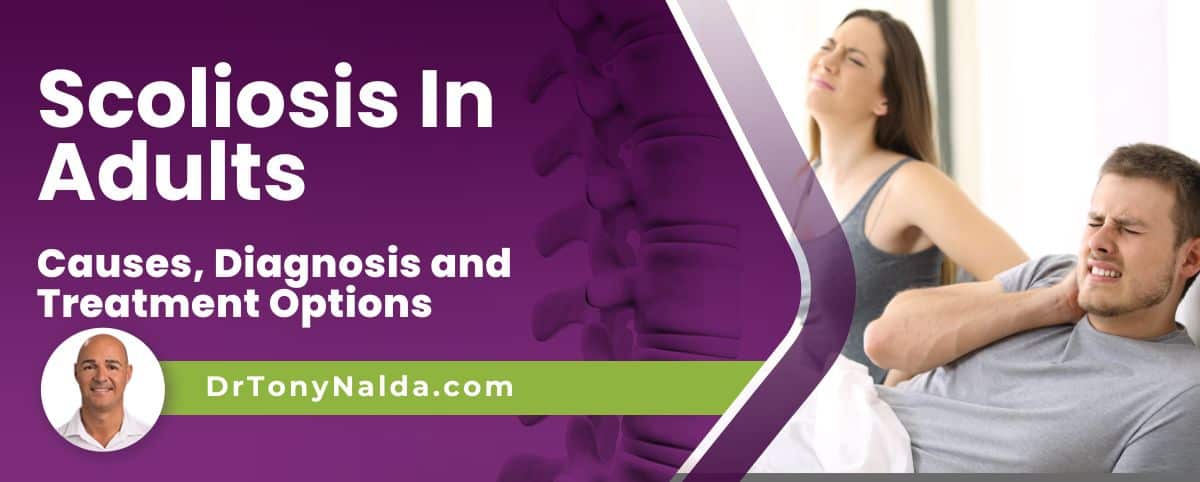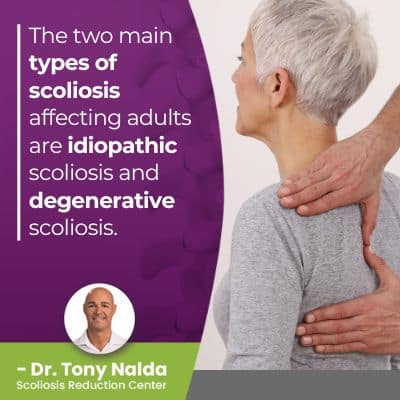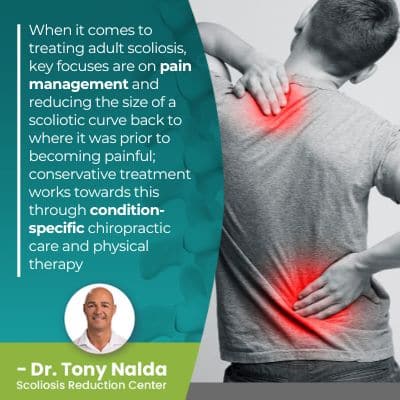Scoliosis In Adults: Causes, Diagnosis and Treatment Options

While scoliosis is often thought of as a childhood condition, the actual rate of scoliosis increases with age, and this is due to natural age-related spinal degeneration. The main difference between scoliosis in children and adults is compression; continue reading to learn more.
Scoliosis affects all ages but is most often diagnosed in children. Scoliosis in adults tends to progress slower than childhood scoliosis, but still needs to be taken seriously and treated proactively. The two main types to affect adults are idiopathic scoliosis and degenerative scoliosis.
Before getting to the specifics of adult scoliosis, let's address the different age groups scoliosis affects.
Table of Contents
Scoliosis and Age
As mentioned, scoliosis is most common in children, but it affects all ages and involves the development of an unnatural sideways-bending and rotating spinal curve.
Congenital scoliosis affects babies who are born with the condition; it's caused by spinal malformations that develop in utero as the spine is forming.
Infantile scoliosis is diagnosed in children between the ages of 6 months and 3 years old; early-onset juvenile scoliosis is diagnosed between the ages of 3 and 10, adolescent idiopathic scoliosis in adolescents between 10 and 18 years old, and adult scoliosis is diagnosed in individuals who have reached skeletal maturity.
No two cases of scoliosis are the same; the complex nature of scoliosis necessitates the customization of effective treatment plans, and an important factor that shapes a patient's experience of life with scoliosis is patient age.
Patient Age: Progression and Pain
When scoliosis is first diagnosed, regardless of age, part of the process involves further classifying conditions based on key patient/condition variables, one of which is patient age.
Patient age is important not only because it helps indicate a patient's overall health and level of fitness, it's also important because of the effects it contributes to.
As mentioned earlier, scoliosis is a progressive condition, and that means it's virtually guaranteed to get worse over time.
Scoliosis progressing means the size of the unnatural spinal curve is increasing, and this means the condition's uneven forces are increasing, as are their effects.
As scoliosis progresses, the spine gets increasingly rigid and less responsive to treatment, hence the benefit of early detection, intervention, and a proactive treatment approach.
We don't know why most cases of scoliosis develop initially, but we do know what triggers them to progress: growth.
So once skeletal maturity has been reached, growth is no longer occurring, but while progression does tend to slow in adults, adults do still progress, particularly once the spine starts to experience degenerative changes.
When treating adolescent idiopathic scoliosis, for example, because of the rapid and unpredictable growth spurts of puberty, this age group is the most at risk for rapid-phase progression: something most adults won't face.
So patient age helps indicate how much of a focus there will need to be on counteracting progression during growth, and it also tells me how likely a patient is to need pain management as a focus of treatment.
Scoliosis doesn't become a compressive condition until skeletal maturity has been reached; when the spine is still growing, it's undergoing a constant lengthening motion that counteracts the compressive force of the unnatural spinal curve.
It's compression of the spine and its surrounding muscles and nerves that causes the majority of condition-related pain, so in children, the condition isn't compressive, but in adults, back pain and pain that radiates into the extremities due to nerve compression is the main condition effect.
Scoliosis in Adults
 There are different types of scoliosis patients can develop, and condition type is determined by causation.
There are different types of scoliosis patients can develop, and condition type is determined by causation.
The majority of scoliosis cases are idiopathic; approximately 80 percent of known cases have no known cause, and the remaining 20 percent are associated with known causes: neuromuscular scoliosis, congenital scoliosis, and degenerative scoliosis.
The two main types of scoliosis affecting adults are idiopathic scoliosis and degenerative scoliosis.
Idiopathic scoliosis in adults are cases of adolescents who developed scoliosis during the teen years but didn't receive a diagnosis or treatment because they were unaware of their condition.
It can seem difficult to understand how someone lives with an unnatural spinal curve for years unaware, but remember, in children, the condition isn't commonly painful, and in mild forms, scoliosis also isn't known to cause noticeable functional deficits, and even postural changes can be subtle.
The reality, however, is that had these patients received a diagnosis and treatment during adolescence, their spines would be in far better shape than they are by the time I see them; that being said, it's never too late to start treatment.
Degenerative scoliosis affects older adults and is caused by natural age-related spinal degeneration and the cumulative effect of certain lifestyle factors.
It's usually the spine's intervertebral discs that are the first spinal structures to start to deteriorate, and a disc sits between adjacent vertebrae providing cushioning, flexibility, structure, and shock absorption.
If a disc starts to degenerate, it can become desiccated and change shape, and this affects the position of adjacent vertebrae attached to the disc in between and can cause the development of an unnatural spinal curve.
Lifestyle factors also factor into a patient's level and rate of natural age-related spinal degeneration: carrying excess weight, leading a sedentary lifestyle, chronic poor posture, and repeatedly lifting heavy objects incorrectly.
Adult Scoliosis Treatment Options
All types and severity levels of scoliosis benefit from treatment, and there are two main treatment approaches for patients to choose between: traditional and conservative treatment.
Traditional scoliosis treatment offers a surgical response, while modern conservative treatment involves a nonsurgical treatment response.
 Scoliosis surgery is a type of spinal fusion; most involve the removal of intervertebral discs sitting between adjacent vertebrae to be fused, and fusing the curve's most-tilted vertebrae into one solid bone so they can't become more tilted over time (progression).
Scoliosis surgery is a type of spinal fusion; most involve the removal of intervertebral discs sitting between adjacent vertebrae to be fused, and fusing the curve's most-tilted vertebrae into one solid bone so they can't become more tilted over time (progression).
Rods are commonly attached to the spine with pedicle screws to hold it in place, and while spinal fusion can successfully straighten a bent spine, the way it does so is invasive and risky, and there is a less-invasive treatment option with proven results.
When it comes to treating adult scoliosis, key focuses are on pain management and reducing the size of a scoliotic curve back to where it was prior to becoming painful; conservative treatment works towards this through condition-specific chiropractic care and physical therapy.
All spinal surgeries come with their share of potential risks, side effects, and complications, so should be considered carefully, while conservative treatment is not as invasive or risky and has the goal of preserving as much of the spine's natural strength and function as possible.
Chiropractic care for adults with scoliosis involve a series of techniques and gentle and precise manual adjustments that work towards adjusting the position of the curve's most-tilted vertebrae back into alignment with the rest of the spine.
As it's not just the spine that has to maintain its natural curves and alignment, but also the role of the spine's surrounding muscles to provide it with optimal support and stabilization, I use physical therapy and scoliosis-specific exercises to increase core strength.
While corrective bracing is a key facet of my treatment for childhood scoliosis, in adults, it's not as useful, and is applied more so for spinal stabilization and short-term pain relief; the goal of treatment is always to reduce the size of the scoliotic curve, but in adults, it's more about reducing it back to the size it was before becoming painful than it is about a significant reduction and holding it there throughout growth.
Rehabilitation is the ongoing part of treatment that involves continued chiropractic care and a series of custom-prescribed home exercises to help patients stabilize and heal their spines from home for long-term sustainable treatment results.
Conclusion
Regardless of age or severity, as a progressive spinal condition, the best time to start scoliosis treatment is always now.
Scoliosis affects all ages, and the two most common types to be diagnosed in adults are idiopathic scoliosis and degenerative scoliosis.
Idiopathic scoliosis in adults shows how important early detection can be; when diagnosed early in a condition's progressive line, preventing progression and increasing condition effects can be worked towards, but when diagnosed after a significant amount of progression has already occurred, the condition is more complex to treat.
In addition to making the spine more rigid and less responsive to treatment, increasing spinal rigidity can also be problematic by making it difficult for patients to perform key therapeutic exercises as part of treatment.
When adult scoliosis is treated proactively, condition improvement that impacts quality of life can be worked towards, and when it comes to traditional surgical treatment, this only gets riskier with age.
Here at the Scoliosis Reduction Center, my patients benefit from a proactive conservative treatment approach that's started as close to the time of diagnosis as possible in the hopes of preventing progression, increasing effects, and the need for invasive surgical treatment.
Dr. Tony Nalda
DOCTOR OF CHIROPRACTIC
After receiving an undergraduate degree in psychology and his Doctorate of Chiropractic from Life University, Dr. Nalda settled in Celebration, Florida and proceeded to build one of Central Florida’s most successful chiropractic clinics.
His experience with patients suffering from scoliosis, and the confusion and frustration they faced, led him to seek a specialty in scoliosis care. In 2006 he completed his Intensive Care Certification from CLEAR Institute, a leading scoliosis educational and certification center.
About Dr. Tony Nalda
 Ready to explore scoliosis treatment? Contact Us Now
Ready to explore scoliosis treatment? Contact Us Now





